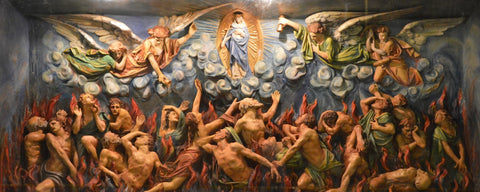Throughout history, mystics and saints have shared remarkable visions of purgatory, providing insights that inspire and encourage the faithful to pray for the departed. Here, we explore three astonishing accounts from three renowned mystics whose visions continue to resonate with the Catholic faithful.
St. Catherine of Genoa
St. Catherine of Genoa, a 15th-century mystic and author of the Treatise on Purgatory, had profound revelations about the nature of purgatory. Unlike depictions of physical torment, St. Catherine’s vision emphasized the purifying power of divine love. She described purgatory as a state where souls are consumed by an intense longing for God and purified through this yearning.
According to St. Catherine, the souls in purgatory experience an overwhelming joy in knowing they are destined for heaven, yet they also endure great suffering due to their separation from God’s presence. This suffering, however, is willingly embraced as it purges them of any remaining impurities. She wrote, “The greatest suffering of the souls in purgatory is the awareness that they delayed their fulfillment of God’s will, and now they must be purified to enter into His glory.” Her vision portrays purgatory not as punishment, but as a place of merciful preparation for the beatific vision.
St. Faustina Kowalska
St. Faustina Kowalska, the 20th-century Polish nun known for her devotion to Divine Mercy, was granted a vivid vision of purgatory. In her Diary: Divine Mercy in My Soul, she recounts being guided by her guardian angel to a place filled with mist and suffering souls. She observed that these souls were in great pain, but their primary torment came from an intense spiritual longing and regret.
“I saw my guardian angel who ordered me to follow him,” St. Faustina wrote. “In a moment, I was in a misty place full of fire in which there was a great crowd of suffering souls.” She noted that the souls could not help themselves and relied solely on the prayers and sacrifices of the living. This vision reinforced her commitment to praying fervently for the dead, understanding that acts of mercy and prayer from the living could expedite the release of souls from purgatory. St. Faustina’s vision served as a powerful reminder of the interconnectedness between the Church on earth and the souls awaiting their final purification.
St. Padre Pio
St. Padre Pio, the beloved 20th-century Capuchin friar known for his miracles and deep spirituality, shared several accounts of his interactions with souls in purgatory. One of his most striking visions occurred when he was visited by a soul seeking prayers. According to St. Pio, he once encountered a deceased friar who appeared to him during prayer and introduced himself as having passed away decades earlier.
The soul revealed that he was in purgatory, suffering greatly for failing to observe aspects of his religious duties. St. Padre Pio, moved by the apparition’s plea, offered Mass and prayers for his deliverance. Soon after, the soul appeared again, this time in radiant glory, thanking the saint and telling him he was now in heaven. St. Padre Pio’s vision underscores the profound impact that prayers, especially the Holy Mass, can have in assisting souls on their journey to eternal rest.
A Call to Prayer and Mercy
These visions from St. Catherine of Genoa, St. Faustina Kowalska, and St. Padre Pio reveal the profound reality of purgatory—not as a place of hopeless torment but as a stage of merciful purification driven by divine love. They remind the faithful that our prayers, sacrifices, and acts of mercy can bring relief to these suffering souls and hasten their entry into heaven.
As we move through November, may these accounts inspire us to dedicate our prayers and offerings to the souls in purgatory, fulfilling our spiritual duty and deepening our hope in God’s infinite mercy and love.

